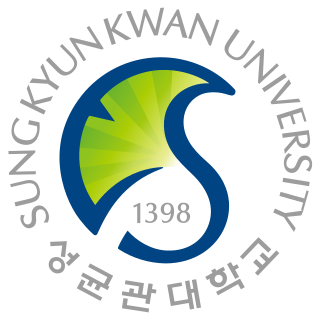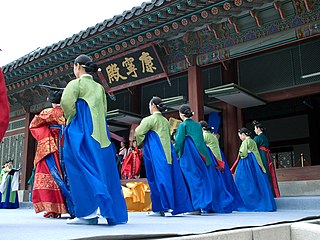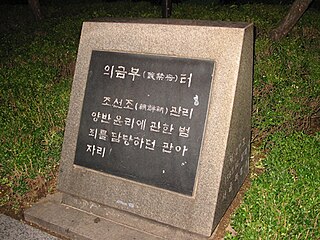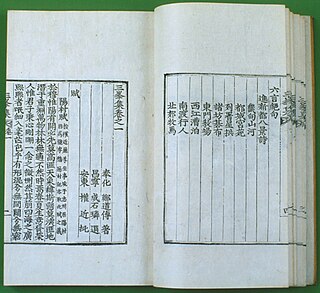
Joseon, officially Great Joseon State, was a dynastic kingdom of Korea that existed for 505 years. It was founded by Taejo of Joseon in July 1392 and replaced by the Korean Empire in October 1897. The kingdom was founded following the aftermath of the overthrow of Goryeo in what is today the city of Kaesong. Early on, Korea was retitled and the capital was relocated to modern-day Seoul. The kingdom's northernmost borders were expanded to the natural boundaries at the rivers of Amnok and Tuman through the subjugation of the Jurchens.

Chŏng To-jŏn, also known by his art name Sambong (삼봉), was a prominent Korean scholar-official during the late Goryeo to the early Joseon periods. He served as the first Chief State Councillor of Joseon, from 1392 until 1398 when he was killed by the Joseon prince Yi Pang-wŏn. Chŏng To-jŏn was an adviser to the Joseon founder Yi Sŏng-gye and also the principal architect of the Joseon dynasty's policies, laying down the kingdom's ideological, institutional, and legal frameworks which would govern it for five centuries.

Sungkyunkwan University is a private research university with campuses in Seoul and Suwon, South Korea.

The Joseon Navy was the navy of the Korean dynasty of Joseon. While originally commissioned to protect merchant vessels and coastal towns from Japanese pirate raids, the Joseon navy is best known for defeating the Japanese naval forces during the Imjin War and is often credited with halting the Japanese invasion campaign and saving the dynasty from conquest.

The Yeonguijeong or Chief State Councilor was a member of the Uijeongbu and the highest government position in Joseon Korea. The Yeonguijeong held roles similar to a modern-day prime minister of a presidential system. As the senior member of the Chief State Council, the Yeonguijeong participated in the administration of general government affairs alongside the Jwauijeong and Uuijeong.

The Jwauijeong, also known as the Left State Councilor or Second State Councilor, was a member of the Uijeongbu. The Jwauijeong was subordinate in rank only to the Yeonguijeong, the highest-ranking official of the Joseon government, during the Joseon dynasty of Korea (1392–1910). Only one official was appointed to the position and was variously referred to as Jwasang, Jwajeongseung, Jwagyu, Jwahap, or Jwadae.

Gungnyeo is a Korean term referring to women waiting on the king and other royalty in traditional Korean society. It is short for "gungjung yeogwan", which translates as "a lady officer of the royal court". Gungnyeo includes sanggung and nain, both of which hold rank as officers. The term is also used more broadly to encompass women in a lower class without a rank such as musuri, gaksimi, sonnim, uinyeo as well as nain and sanggung. The term spans those from courtiers to domestic workers.
Uinyeo were female physicians who specialized in the treatment of women during the Joseon period of Korea. The uinyeo were established as a solution to social taboos against women receiving treatment from male physicians. The uinyeo system first appeared in 1406 after King Taejong ordered its establishment in the Jesaengwon.
Sanggung was an official title of the senior 5th rank, the highest attainable for gungnyeo, a lady-in-waiting during the Joseon Dynasty of Korea. Female officers with the title were assigned to govern the inner affairs of the palace. When a regular nain served for more than 15 years, she would be awarded with an ornamental hairpin for a sanggung. Therefore, a newly appointed sanggung was usually 35–45 years old. A court lady at the rank of sanggung was treated well enough to live in her own house with servants.
The Seungjeongwon was the Royal Secretariat during the Joseon dynasty of Korea (1392–1910) in charge of receiving and delivering the king's order. The office was also called Jeongwon, Huwon, Eundae, or Daeeonsa. According to the Gyeongguk daejeon, the Seungjeongwon had six royal secretaries, whose ranks were in the 3rd senior grade, as well as two recorders. The duties of the royal secretaries were primarily to deliver the monarch's orders to government organizations and to report on official affairs of the state organizations to the throne. The six secretary system is explained by the fact that the government of Joseon was composed of six boards. The six secretaries served respectively the Boards of Personnel, War, Taxation, Rites, Works, and Punishment. However, the secretaries were not limited to liaison work between the six boards and the monarch; they also reported to the king the business of all government offices, primary among these being the State Council (Uijeong-bu), the Office of Censor-General (Saganwon), and the Office of Inspector-General (Saheon-bu). As the name implies, the primary duty of the recorders was to make a record of all the official business handled by the secretaries. As the work of the secretaries had to be conducted at all hours, and it was required that they have ready access to the monarch at all times, the office of the Seungjeongwon was established within easy reach of the king at court.

Gyuhap chongseo is a compendium of advice for women, written by Yi Bingheogak in 1809 during the Korean Joseon Dynasty.

Jumak (Korean: 주막) were traditional Korean taverns or inns that provided alcohol, food, and lodgings to travellers. They are also called juju, juga, or jupo. Jumak were abundant during the Joseon Dynasty and could be found in both rural and urban areas. Jumak came in many varieties with some having stables for livestock, courtyards, and gardens.
Queen Ansun of the Cheongju Han clan, was the second wife and queen consort of King Yejong, the 8th Joseon monarch. She was queen consort from 1468, until her husband's death in 1469, after which she was honoured as Queen Dowager Inhye (인혜왕대비) during her adoptive son, King Seongjong’s reign, and later as Grand Queen Dowager Inhye (인혜대왕대비) during her grandnephew, King Yeonsangun’s reign.

Uigeumbu, also known as Geum-o or Wangbu in the Joseon dynasty of Korea, was the royal law enforcement body responsible for prosecuting treason and moral crimes based on Confucian principles. Ordinary crimes were investigated and prosecuted by Hyeongjo. It played a crucial role in strengthening the authority of the monarchy.

The history of education in Korea can be traced back to the Three Kingdoms of Korea, or even back to the prehistoric period. Both private schools and public schools were prominent. Public education was established as early as the 400 AD. Historically, the education has been heavily influenced by Confucianism and Buddhism.

Queen Sohye, of the Cheongju Han clan, was the only wife of Crown Prince Uigyeong. She never was the consort of a reigning king. Nevertheless, she was honored as Queen Insu (인수왕후) and later as Queen Dowager Insu (인수왕대비) during the reign of her son Yi Hyeol, King Seongjong. Moreover, she was later honored as Grand Queen Dowager Insu (인수대왕대비) during the reign of her grandson Yi Yung, Prince Yeonsan. After her death, she was posthumously honored with the title Queen Sohye (소혜왕후).

Yeolnyeo, also called Yeolbu, is defined as 'virtuous woman' during the Joseon dynasty of Korea.
Princess Myeongsuk, or Princess Myeongui, posthumously honoured as Princess Taean, was a Joseon Princess as the only daughter of Deokjong of Joseon and Queen Insu.
Prince Hwaui Korean: 화의군; 5 September 1425 – 1460), personal name Yi Yeong 이영), was a prince of the Joseon period of Korea. He was the sixth son of Sejong the Great and younger brother of Munjong of Joseon and Sejo of Joseon.

Sambongjip (삼봉집) is a collection of works by Jeong Do-jeon (정도전), a key figure in the founding of Joseon and in the creation of Joseon's philosophy of government. It is a compilation of Jeong Do-jeon (Sambong)'s poetry, prose, philosophy, and his plans for the reformation of the Goryeo /Joseon) government.














